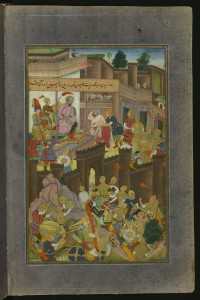By Pamela Toler (Wonders and Marvels Contributor)
Zahir-u-din Muhammad Babur was the first Mughal ruler of India–one of history’s great empire builders by any standard.
Born in 1483 in the Central Asian kingdom of Ferghana (part of modern Uzbekistan), Babur was descended from two great conquerors: Genghis Khan and Timur (known in the west as Tamurlane). After being edged out of his own kingdom, he conquered Samarqand when he was thirteen, lost it, conquered it again when he was nineteen, and lost it again a year later. He carved out a new kingdom for himself in the mountains of Afghanistan and then went on to conquer a large section of northern India.
Much of what we know about him comes from his autobiography, the Baburnama (Book of Babur). It’s not clear what inspired Babur to write his memoirs. Historical accounts were popular in the Islamic world of his time, but there was no tradition of royal memoirs. His choice of language was also unusual. Babur was perfectly at home writing Persian, the literary language of Central Asia at the time. But he chose to write the Baburnama in Chagaty Turkish, the language spoken by himself and his people.
The memoir is lively, personal and direct. Babur begins the story when he inherited the throne at the age of twelve and ends in mid-sentence in September, 1529, a year before his death. He paints a picture of a warrior who partied as hard as he fought. He loved wine, melons, and gardens. He hated India, which was, in his opinion, lacking in all three. He was proud of his ability to write Persian poetry–and pleased to recite it at a party. (Poetry was a courtly skill and popular party game in the Central Asia kingdoms of the fifteenth and sixteenth century, just as it was in Elizabethan England and eighteenth century France.) He tells us what he did, thought and saw–not to mention how much he drank and how sick he was afterwards. He details who was at each event and why their presence was important. He outlines his military strategy at important battles. He complains about India, which he described as “a place of little charm”, but describes its animal and plant life with careful, loving detail.
It is, in short, an intimate self-portrait of a prince, warts, binge drinking, and all. “I have simply written the truth,” he tells the reader at one point. “I do not intend by what I have written to compliment myself: I have simply set down exactly what happened…May the reader excuse me; may the listener not take me to task.” Speaking only for myself, this reader hung on every word.
Image courtesy of the Walters Art Museum

